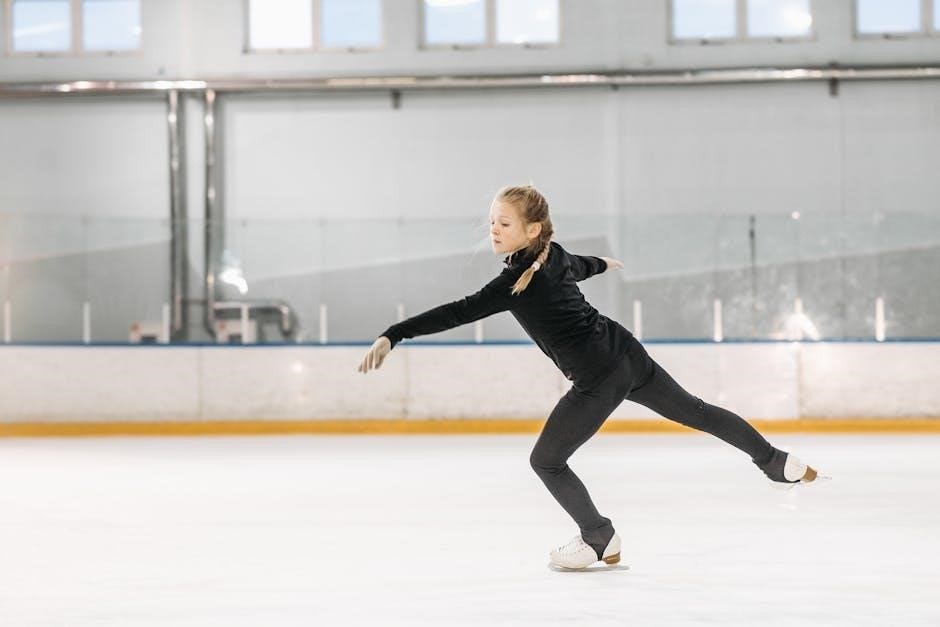Tendon gliding exercises are essential for maintaining healthy tendon mobility and preventing injuries. They involve specific movements to improve flexibility and reduce swelling in hands and fingers.
1.1 What Are Tendon Gliding Exercises?
Tendon gliding exercises are specific movements designed to improve tendon mobility and flexibility in the hands and fingers. They involve bending and straightening fingers in precise positions‚ such as straight‚ hook‚ fist‚ and tabletop‚ to ensure tendons glide smoothly. These exercises are crucial for maintaining hand function‚ preventing injuries‚ and reducing swelling. They are often recommended for conditions like carpal tunnel syndrome and post-surgical recovery. Regular practice helps maintain tendon health‚ similar to how aerobic exercises benefit the heart‚ making them essential for overall hand wellness and injury prevention.
1.2 Importance of Tendon Gliding Exercises
Tendon gliding exercises are vital for maintaining hand and finger function. They enhance mobility‚ reduce swelling‚ and prevent tendon-related injuries. Regular practice ensures tendons move smoothly‚ improving dexterity and strength. These exercises are particularly beneficial for conditions like carpal tunnel syndrome and post-surgical recovery‚ aiding in faster rehabilitation. By incorporating tendon gliding into daily routines‚ individuals can maintain optimal tendon health‚ prevent future issues‚ and sustain overall hand wellness effectively.

Benefits of Tendon Gliding Exercises
Tendon gliding exercises improve mobility‚ reduce swelling‚ enhance flexibility‚ and prevent injuries. Essential for hand health‚ they are as vital as regular aerobic exercises for the heart.
2.1 Improving Tendon Mobility
Tendon gliding exercises enhance tendon mobility by promoting smooth movement within the tendon sheaths. Regular practice reduces friction between tendons and surrounding tissues‚ improving flexibility and range of motion.
2.2 Reducing Hand Swelling
Tendon gliding exercises help reduce hand swelling by improving circulation and promoting lymphatic drainage. Regular practice enhances blood flow‚ which aids in reducing fluid retention and inflammation in the hands and fingers. This makes the exercises particularly beneficial for individuals with conditions like carpal tunnel syndrome or post-surgical recovery. By maintaining tendon mobility‚ these exercises also prevent stiffness‚ further contributing to overall hand health and functionality. Consistent practice is key to achieving these benefits and sustaining long-term results.
2.3 Enhancing Finger Flexibility
Tendon gliding exercises are designed to improve finger flexibility by ensuring tendons move smoothly through their natural range of motion. These exercises target the tendons responsible for bending and straightening fingers‚ promoting elasticity and strength. Regular practice helps prevent stiffness and maintains dexterity‚ which is crucial for everyday activities. Enhanced flexibility also reduces the risk of tendon-related injuries‚ making these exercises a valuable addition to hand therapy routines. Consistent practice ensures optimal tendon health and finger mobility‚ addressing both preventive and rehabilitative needs effectively.
2.4 Preventing Tendon-Related Injuries
Tendon gliding exercises play a crucial role in preventing injuries by strengthening tendons and improving their resilience; Regular practice enhances tendon flexibility and reduces friction‚ lowering the risk of strains or tears. These exercises are particularly beneficial for individuals with repetitive hand movements or those recovering from injuries. By maintaining proper tendon function‚ they help avoid conditions like tendinitis or carpal tunnel syndrome. Incorporating these exercises into a daily routine is a proactive approach to safeguarding tendon health and ensuring long-term hand functionality.

Types of Tendon Gliding Exercises
Tendon gliding exercises include Straight‚ Hook‚ Fist‚ and Table Top positions. Each targets specific tendon movements‚ improving flexibility and reducing stiffness in hands and fingers effectively.
3.1 Straight Position Exercise
The Straight Position Exercise is the foundation of tendon gliding exercises. Start with your fingers and wrist fully extended in a neutral position. Slowly bend each finger one by one‚ keeping the others straight‚ to allow the tendons to glide smoothly. This exercise is essential for maintaining tendon mobility and preventing stiffness. It is often recommended to hold each position for 3-5 seconds and repeat the cycle 5-10 times daily to achieve optimal results. Consistency is key to improving flexibility and reducing swelling in the hands and fingers.
3.2 Hook Position Exercise
The Hook Position Exercise involves bending your fingers to form a hook shape‚ with the fingertips curved towards the palm. Start with straight fingers‚ then gradually bend just the tips while keeping the base joints straight. This exercise targets the tendons responsible for finger flexion‚ promoting smooth gliding and reducing stiffness. Hold the hook position for 3-5 seconds before returning to the straight position. Repeat this motion 5-10 times per session‚ ensuring consistent practice to enhance tendon mobility and flexibility in the hands. Regular performance helps maintain optimal tendon function and prevents swelling.
3.3 Fist Position Exercise
The Fist Position Exercise involves curling all fingers into a tight fist‚ keeping the wrist straight. Slowly bend the fingers down toward the palm‚ starting from a straight position. This exercise strengthens the flexor tendons and improves hand grip. Hold the fist for 3-5 seconds‚ then slowly release back to the starting position. Perform 5-10 repetitions per session‚ focusing on controlled movements to prevent strain. Regular practice enhances tendon flexibility and reduces the risk of hand swelling‚ ensuring optimal tendon health and functionality.
3.4 Table Top Position Exercise
The Table Top Position Exercise begins with the hand flat on a surface‚ fingers straight. Slide the fingers backward‚ keeping the palm down‚ then bend the fingers to touch the tabletop. This movement mimics the natural gliding of tendons. Repeat 5-10 times‚ holding each position for 3-5 seconds. This exercise improves tendon mobility and reduces stiffness‚ promoting smooth movement in the hands. Regular practice enhances flexibility and prevents tendon-related injuries‚ ensuring optimal hand function and dexterity.

How to Perform Tendon Gliding Exercises
Start with fingers straight‚ then slide into hook‚ fist‚ and table top positions. Hold each for 3-5 seconds‚ repeat 5-10 times daily for optimal tendon mobility.

4.1 Starting Position
Begin with your fingers and wrist in a straight‚ neutral position. This is the foundation for all tendon gliding exercises. Ensure your fingers are fully extended and your wrist is flat‚ forming a straight line from your forearm to your fingertips. This starting position allows for optimal tendon mobility and prevents strain. It is crucial to maintain proper alignment to achieve the full benefits of the exercises and avoid potential discomfort or injury. Consistency in starting position ensures effective progression through each movement pattern.
4.2 Number of Repetitions
Perform each tendon gliding exercise 5-10 times per session. According to resources like Hamilton Health Sciences and The New York Hand and Wrist Center‚ repeating exercises multiple times ensures consistent improvement in tendon mobility. Start with 3-5 sets and gradually increase as comfort allows. Regularity is key to achieving optimal results. Always follow the recommended repetitions to avoid overexertion and maintain steady progress in your hand therapy routine.
4.3 Duration of Each Stretch
Hold each tendon gliding stretch for 3-5 seconds to ensure proper tendon mobility. According to guidelines from The New York Hand and Wrist Center‚ this duration allows tendons to glide smoothly without strain. Holding for shorter periods may not effectively promote flexibility‚ while longer holds could cause discomfort. Maintain consistent timing to optimize benefits and support tendon health. Resources like Hamilton Health Sciences and St Georges Hospital recommend this approach for effective hand therapy routines.
4.4 Frequency of Exercises
Perform tendon gliding exercises 3-5 times daily for optimal results. According to The New York Hand and Wrist Center‚ consistent practice helps maintain tendon mobility. Start with lower frequency and gradually increase as comfort allows. Hamilton Health Sciences recommends 3-5 repetitions per session‚ ensuring regularity without overexertion. Adjust frequency based on individual tolerance and therapeutic goals‚ as advised by hand therapy guidelines. Proper adherence ensures sustained improvement in tendon health and hand functionality over time.
Tendon Gliding Exercises for Specific Conditions
Tendon gliding exercises are tailored to address conditions like carpal tunnel syndrome and post-surgical rehabilitation‚ promoting recovery and preventing further tendon-related issues effectively.

5.1 Carpal Tunnel Syndrome
Tendon gliding exercises are highly beneficial for managing carpal tunnel syndrome by improving median nerve mobility and reducing compression. These exercises‚ such as the six-position median nerve gliding sequence‚ help alleviate symptoms like numbness and tingling. Regular practice can prevent further nerve damage and improve hand function. Studies show that consistent tendon gliding exercises can often delay or even eliminate the need for surgical intervention‚ making them a vital component of conservative treatment plans for carpal tunnel syndrome.
5.2 Post-Surgical Rehabilitation
Tendon gliding exercises play a crucial role in post-surgical rehabilitation‚ particularly after procedures like flexor tendon reconstructions. These exercises help restore tendon mobility and prevent adhesions‚ ensuring proper healing. A structured program‚ including straight‚ hook‚ and fist positions‚ is often recommended. Early initiation of these exercises‚ as outlined in post-surgical guidelines‚ promotes faster recovery and improves hand functionality. Consistency and adherence to prescribed repetitions and durations are essential for optimal outcomes‚ helping patients regain full range of motion and strength in their hands and fingers after surgery.
5.3 Preventive Care for Tendon Health
Tendon gliding exercises are a proactive approach to maintaining tendon health and preventing conditions like carpal tunnel syndrome. Regular practice improves tendon mobility and reduces the risk of injuries. By incorporating exercises such as straight‚ hook‚ and fist positions‚ individuals can enhance flexibility and strength in their hands. Consistency is key‚ with exercises recommended multiple times a day. These simple yet effective movements are a valuable tool in preventive care‚ promoting long-term tendon health and functionality.

Safety and Precautions
Always consult a healthcare professional before starting tendon gliding exercises to ensure they are appropriate for your condition. Avoid overexertion and monitor pain levels to prevent injury;
6.1 Consulting a Healthcare Professional
Consulting a healthcare professional is crucial before starting tendon gliding exercises‚ especially for conditions like carpal tunnel syndrome or post-surgical recovery. They provide personalized advice‚ ensuring exercises are suitable for your specific condition. A therapist can demonstrate proper techniques to avoid injury and maximize benefits. Regular follow-ups help monitor progress and adjust routines as needed. This step ensures safety and effectiveness‚ particularly for those with severe hand or finger injuries. Always seek professional guidance to tailor exercises to your needs and prevent overexertion or pain escalation.
6.2 Avoiding Overexertion
Avoiding overexertion is key when performing tendon gliding exercises. Start with gentle movements and gradually increase intensity. Overexertion can lead to tendon strain or injury; Always follow the recommended number of repetitions and duration. If pain occurs‚ stop immediately and consult a professional. Holding stretches too long or repeating exercises excessively can cause discomfort. Prioritize a balanced approach to ensure safe and effective progress. Proper technique and moderation are essential to avoid setbacks and promote tendon health.

6.3 Monitoring Pain Levels
Monitoring pain levels is crucial while performing tendon gliding exercises. If pain occurs‚ stop immediately and consult a healthcare professional. Mild discomfort is normal‚ but sharp pain may indicate overexertion. Adjust the intensity or frequency of exercises based on pain response. Avoid pushing through pain‚ as it can lead to tendon inflammation or injury. Pain serves as a guide to ensure exercises are done safely and effectively‚ promoting recovery without causing harm. Always prioritize comfort and gradual progression to maintain tendon health and avoid setbacks.
Tendon Gliding Exercises for Different Fingers
Tendon gliding exercises are tailored for each finger to enhance mobility and dexterity. They target specific tendons‚ improving flexibility and reducing stiffness in the index‚ middle‚ ring‚ and pinky fingers.
7.1 Index Finger Exercises
Index finger tendon gliding exercises focus on isolated movements to enhance tendon mobility. Start with the finger straight‚ then gently bend the tip without moving other fingers. Hold each position for 5-10 seconds‚ repeating 8-10 times. Perform these exercises 3-4 times daily to improve flexibility and prevent stiffness. Regular practice helps maintain tendon health and reduces the risk of injury‚ ensuring optimal finger function and dexterity in daily activities. These exercises are simple yet effective for promoting long-term tendon integrity and mobility in the index finger.
7.2 Middle Finger Exercises
Middle finger tendon gliding exercises target the flexor tendons to improve mobility and strength. Begin with the finger straight‚ then bend the tip and middle joint‚ holding each position for 5-10 seconds. Repeat 8-10 times per session‚ 3-4 times daily. These exercises help reduce stiffness‚ enhance dexterity‚ and prevent tendon-related injuries. Consistent practice supports long-term tendon health‚ ensuring smooth movement and functionality of the middle finger in various activities. They are crucial for maintaining hand function and overall tendon integrity in the middle finger;
7.3 Ring Finger Exercises
Ring finger tendon gliding exercises focus on enhancing tendon mobility and flexibility. Start with the finger straight‚ then bend the tip and middle joint‚ forming a hook shape. Hold each position for 5-10 seconds‚ repeating 8-10 times per session. Perform these exercises 3-4 times daily to improve range of motion and reduce stiffness. Regular practice helps prevent injuries and maintains tendon health‚ ensuring the ring finger moves smoothly and effectively in daily activities and tasks requiring dexterity and strength.
7.4 Pinky Finger Exercises
Pinky finger tendon gliding exercises target the tendons in the smallest finger to enhance mobility and strength. Start with the finger straight‚ then gently bend the tip toward the palm‚ followed by a hook position. Hold each position for 5-10 seconds‚ repeating 8-10 times per session. Perform these exercises 3-4 times daily to improve flexibility and reduce stiffness. Regular practice helps maintain tendon health‚ ensuring the pinky finger moves smoothly and effectively in daily activities requiring precision and dexterity.

Role of Tendon Gliding in Hand Therapy
Tendon gliding exercises are crucial in hand therapy as they improve tendon mobility‚ reduce swelling‚ and enhance flexibility‚ making them vital for overall hand health and function.
8.1 Active vs. Passive Exercises
Active exercises involve using your own muscle power‚ while passive exercises rely on external assistance. Active exercises strengthen muscles and improve mobility‚ making them ideal for tendon gliding. Passive exercises‚ guided by a therapist‚ are beneficial when movement is challenging. Both methods enhance flexibility and reduce stiffness‚ promoting overall hand function. Combining active and passive techniques ensures a comprehensive approach to hand therapy‚ catering to different patient needs and recovery stages.
8.2 Combining with Other Therapies
Tendon gliding exercises are often combined with other therapies‚ such as heat therapy‚ splinting‚ or massage‚ to enhance recovery and improve hand function. These combinations help reduce stiffness‚ promote healing‚ and restore mobility. For example‚ using heat therapy before exercises can relax tendons‚ making movements more effective. Splinting may also be used to support the hand during exercises. A tailored approach‚ guided by a therapist‚ ensures the best outcomes for patients with specific conditions like carpal tunnel syndrome or post-surgical rehabilitation.
8.3 Monitoring Progress
Regularly monitoring progress in tendon gliding exercises is crucial for ensuring effectiveness and adjusting therapy. Patients should track improvements in range of motion‚ strength‚ and pain levels. Using a journal to document exercises and outcomes helps identify patterns and areas needing adjustment. Therapists often use assessments like goniometric measurements or functional tests to evaluate progress. Adjustments to the exercise regimen may be necessary based on these evaluations to achieve optimal recovery and maintain patient motivation throughout the rehabilitation process.
Tendon Gliding Exercises PDF Resources
Tendon gliding exercises PDF resources provide detailed guides and step-by-step plans. Popular guides include those from Hamilton Health Sciences and The New York Hand and Wrist Center.
9.1 Recommended PDF Guides
Recommended PDF guides for tendon gliding exercises include resources from Hamilton Health Sciences and The New York Hand and Wrist Center. These guides offer structured programs with clear instructions and visuals‚ ensuring proper technique. They often include exercises like straight‚ hook‚ fist‚ and tabletop positions‚ each designed to target specific tendons. Additionally‚ some PDFs provide progress tracking and tips for incorporating exercises into daily routines. They are ideal for both patients and practitioners‚ promoting consistent practice and optimal results.
9.2 Step-by-Step Exercise Plans
Step-by-step exercise plans in tendon gliding exercise PDFs provide clear‚ structured routines. They detail starting positions‚ repetitions‚ and holding times for each movement. Plans often include exercises like straight‚ hook‚ fist‚ and tabletop positions‚ with instructions for daily practice. Visual guides and progress tracking are common features. These plans are designed to improve tendon mobility‚ reduce swelling‚ and enhance hand function. They are ideal for both patients and professionals‚ ensuring consistent and effective practice tailored to individual needs.
Tendon gliding exercises are vital for improving mobility‚ reducing swelling‚ and preventing injuries. Regular practice enhances hand function and overall tendon health‚ supported by structured PDF guides.
10.1 Summary of Key Points
Tendon gliding exercises are crucial for improving tendon mobility‚ reducing hand swelling‚ and preventing injuries. They enhance finger flexibility and promote recovery‚ especially for conditions like carpal tunnel syndrome. Regular practice‚ as outlined in PDF guides‚ ensures consistent progress and long-term hand health. These exercises are simple‚ effective‚ and essential for maintaining optimal tendon function and overall hand wellness‚ making them a cornerstone of hand therapy and preventive care.
10.2 Encouragement for Regular Practice
Consistency is key to maximizing the benefits of tendon gliding exercises. Incorporating these exercises into your daily routine can significantly improve hand mobility and reduce the risk of tendon-related issues. Over time‚ regular practice strengthens tendons‚ enhances flexibility‚ and promotes overall hand health. By following the structured plans in available PDF guides‚ you can maintain a consistent regimen tailored to your needs. Dedication to these exercises ensures long-term benefits and supports a proactive approach to tendon care and injury prevention.
